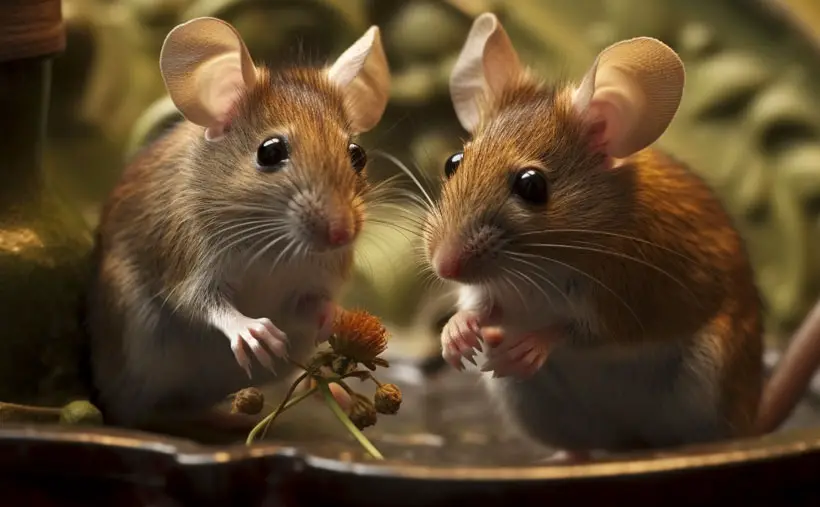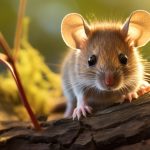What Do Mice Sound Like? [Squeaks to Symphony]
If there are mice in your house, you can hear strange sounds. Mice use these high-pitched noises to communicate with one another.
So, what do mice sound like? Mice make several different noises, from high-pitched squeaks to ultrasonic vocalizations. Squeaks, chirps, and ultrasonic vocalizations are just a few of the different vocalizations that mice make. And these noises are used for a variety of communication activities.
To know more and clarify your doubts, stay with this article. Here you can get a lot of interesting information also.
What Do Mice Sound Like?
Mice may make a variety of vocalizations that are used for various forms of communication. The many vocalizations frequently heard in mice include the following:

Squeaks
Mice make squeaks, which are brief, high-pitched noises. They are among the most distinctive mouse vocalizations.
Chirps
These softer, more musical vocalizations are called chirps. Positive social relationships are frequently linked to these soothing, rhythmic sounds.
Trills
Mice make quick, musical-sounding vocalizations known as trills. They are frequently connected to mating and wooing behavior. Male mice may make trills before or after mating in order to entice females.
Ultrasonic Vocalizations (USVs)
Mouse vocalizations that are too high for human hearing are known as ultrasonic vocalizations. Especially during social interactions and parental care. These high-frequency vocalizations are crucial for mouse communication.
It’s vital to remember that several mouse species may have unique vocalizations.
Mechanism of Mouse Sounds
Mice’s vocal apparatus has special anatomy and physiology that allows them to make a variety of vocalizations. Here is a summary of the vocal tract’s anatomy and physiology in mice:

Vocal Chords
Mice have voice chords, which are housed inside their larynx. Elastic tissues that are stretched across the larynx’s aperture make up the voice cords.
Larynx
The larynx, sometimes known as the voice box, is a throat-based structure. It serves as a safety valve for the respiratory system and contains voice chords. Controlling airflow and generating vocalizations are both important functions of the larynx.
Respiratory System
Mice’s respiratory system, which includes the lungs, diaphragm, and trachea, is involved in the generation of vocalizations. When mice vocalize, their respiratory system is used to regulate the airflow. It pushes air past their vocal cords, which produce sound.
In spite of this, mice are able to communicate successfully within their species. It conveys a variety of messages and promotes social connections. This is possible because of the synchronization between the vocal cords, larynx, and respiratory system.
Analysis of Mouse Sounds
To record and analyze mouse vocalizations, researchers utilize specialized tools and techniques.

An overview of the techniques and tools employed in the investigation of mouse vocalizations is provided below:
Recording Tools and Microphones
- Specialized Microphones: Researchers employ sensitive microphones that can record a variety of frequencies, including ultrasonic vocalizations. These microphones are made to capture noises in the frequency range that mice make.
- Ultrasonic detectors: These are used by researchers to record ultrasonic vocalizations. They are able to detect noises that are beyond the range of human hearing.
Recording Setups and Chambers
- Sound Isolated Chambers: Researchers place mice in sound-isolated chambers or other specifically made cages. This minimizes outside noise interference to decrease background noise and assure reliable recordings.
- Multi-Channel Recordings: It is possible to deploy several microphones or ultrasonic detectors in well-chosen locations. This is to record mouse vocalizations from a variety of perspectives or in a variety of social contexts.
Acoustic Evaluation and Spectrum Analysis
- Acoustic Analysis: Using specialist software that enables in-depth investigation of numerous acoustic properties. These recorded vocalizations are examined in detail. This study extracts the duration, frequency, amplitude, and temporal patterns of vocalizations.
- Spectrograms: Spectrograms are graphical depictions of sound that show the frequency of the sound over time. Researchers can recognize and categorize various vocalizations and ascertain their frequency range.
And discover minute changes in pitch, intensity, and timing by looking at spectrograms.
Researchers can now record and comprehend the complex world of mouse vocalizations. This is possible for sophisticated microphones, recording technology, and acoustic analytic methods.
Differences in Mouse Vocalizations
Age, sex, context, and individual variances are just a few of the many variables. That might affect a mouse’s vocalizations, which can differ greatly. Let’s have a look at these impacts in more detail:

Age
Mice pups utilize vocalizations to communicate with their mothers. These are common, especially when they need care or attention from their moms. As the pups grow and develop, their vocalizations shift in terms of form and frequency.
Sex
Male and female mice may have different vocalization patterns depending on their territorial communication. Male mice, for instance, frequently use particular vocalizations. For example, trills to entice female partners, establish dominance, or fend off competing males.
Context
Vocalizations’ meaning and application are influenced by the situation in which they are made. These are based on social interactions, mating rituals, distress, or territorial conflicts. Depending on the particular circumstances, the same sort of vocalization might communicate a variety of signals.
Individual Variations
Mice may display unique variations in their vocalization patterns, much like people can. These variations could be impacted by inherited genes, personality characteristics, or particular experiences. It’s possible that some mice vocalize more frequently or clearly than others.
Genetic Influences
The variance in vocalization patterns among mice is influenced by genetics. Certain genes can influence the structure and operation of the vocal apparatus.
Environmental Elements
Mice’s vocalizations can be affected by their surroundings. It includes social interactions, housing circumstances, and exposure to various stimuli. Vocalizations can change in expressiveness in reaction to certain stimuli or social cues due to environmental influences.
Understanding mouse vocalization variety is crucial for understanding the genetic underpinnings, social behaviors, and communication activities of mice.
Applications and Consequences
The study of mouse noises has several real-world applications in a variety of industries. Understanding mouse vocalizations has crucial ramifications in the following prominent areas:

Laboratory Analysis
- Behavioral Studies: Mouse vocalizations are useful instruments in laboratory studies for examining behavior, social relationships, and communication dynamics. This is in between mouse colonies, according to behavioral studies.
Vocalizations can shed light on social stratification, territoriality, and the interplay between genetic and environmental influences.
- Modeling illnesses: Mice are an important resource for researching human diseases. Researchers can find vocal biomarkers linked to certain genetic abnormalities, neurodevelopmental problems, or communication deficits.
This is by analyzing the vocalizations of these individuals. Understanding disease processes and creating diagnostic tools can both benefit from this information.
Pest Management Techniques
- Detection and Monitoring: Mouse vocalizations can be employed in pest management methods to identify and keep track of mouse populations.
In places that are prone to infestations, specialized acoustic sensors or microphones can be used. And we can detect it early and help with focused pest control measures.
- Identification of the species: Mice of different species may have distinctive vocalizations. Studying these vocalizations can help identify specific mouse species that are prevalent in a certain location.

Bioacoustics
- Ecosystem Monitoring: Research on biodiversity and ecosystem monitoring can benefit from analyzing mouse vocalizations. Researchers may learn more about mouse population, dynamic species and diversity via the study of vocalizations.
These factors are markers of the overall health and functioning of an ecosystem.
- Species Communication: Comparative studies of mouse vocalizations help researchers comprehend the development of communication systems among other species.
By comparing vocalizations, social systems, and evolutionary processes, scientists can investigate the connection between vocalizations.
Research on mouse vocalizations has implications in bioacoustics, pest management methods, and laboratory research.
While understanding the sounds mice make is crucial to identifying their presence, it’s equally important to know about their reproductive habits and where they call home. Mice have a remarkable ability to multiply at alarming rates. Discover more about their reproductive speed and the factors that influence it in our detailed guide on how fast mice reproduce. Furthermore, understanding their nesting habits can offer insights into where to find them and how to best address an infestation. Delve deeper into the world of mice habitats by checking out our article on mice nests.FAQs
There are some commonly asked questions by people about what mice sound like.
Q: What does a mouse in the wall sound like?
You could hear mice running around in your ceiling and walls. Since mice are most active at night, hearing squeaking, skittering, or gnawing sounds is common. These sounds come from inside walls and might indicate that mice have moved in.
Q: Are mice loud at night?
Yes. When they are looking for food and water inside dwellings, mice tend to be the loudest. And the most probable time for householders to hear mouse noises is at night since this often occurs 30 minutes after sunset and 30 minutes before sunrise.
The mice create loud squeaking noises in addition to scratching noises as they feed.
Q: Do mice fear noise?
Yes. Loud noises imply danger, which mice prefer to stay away from. Being around a lot of noise is not ideal for mice. They like to be alone, away from people and other animals.
Conclusion
Mice produce an extensive range of sounds during their vocalizations. They have a variety of vocalizations that they use to communicate among their social groups. This ranges from high-pitched squeaks to beautiful chirps and trills. Age, sex, context, and individual variability are only a few of the variables.
These can have an impact on these vocalizations. The study of mouse vocalizations has enormous potential to increase knowledge in a variety of areas. The areas include communication technologies, bioacoustics, human speech impairments, and laboratory research.




